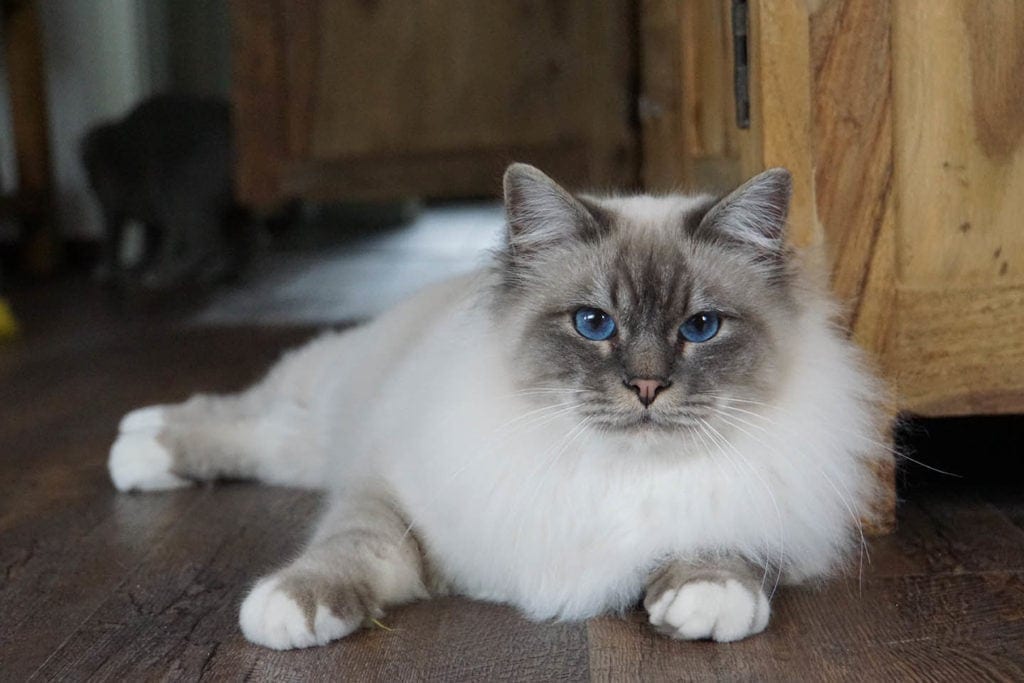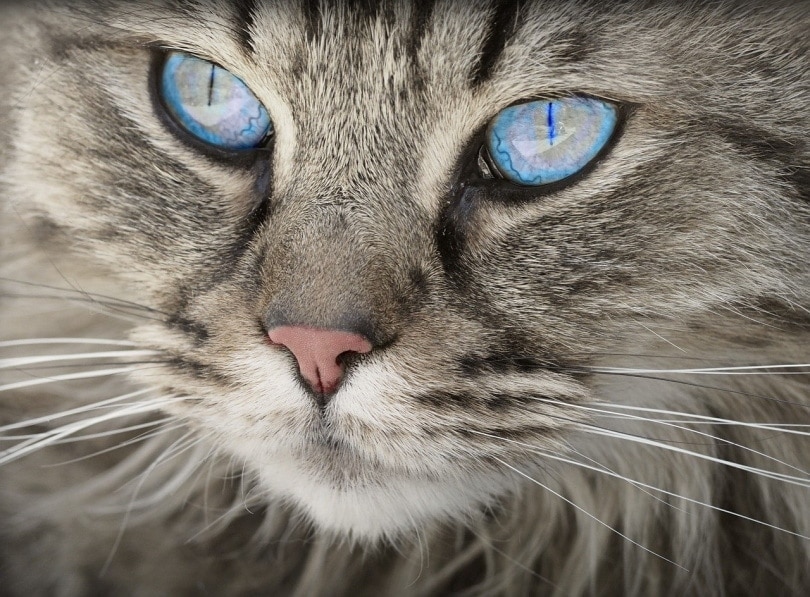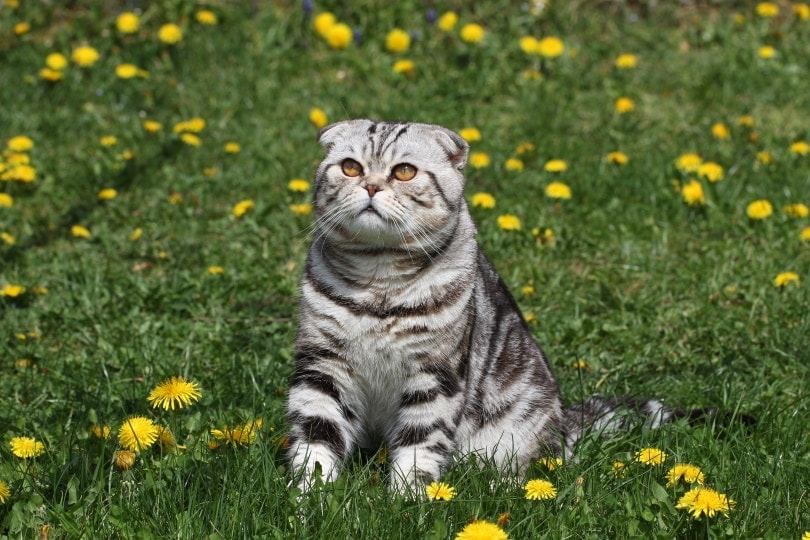Birman Cat: Info, Pictures, Characteristics & Facts
Updated on

| Height | 8–10 inches |
| Weight | 9–12 pounds |
| Lifespan | 9–15 years |
| Colors | Pointed: Blue, seal, red, frost, chocolate, cinnamon, fawn, lilac, cream |
| Suitable for | Families, individuals, seniors |
| Temperament | Calm, quiet, loving, curious, playful, laidback, devoted |
Birman cats have also been called the “Sacred Cats of Burma” and have a remarkable mythological story surrounding their origins. Their actual origins remain a mystery. But what we do know is that in the 1920s, these cats arrived in France and were named Birmanie (Birman for short), which is a translation of “Burma” in French.
Birmans are medium to large cats with long, silky fur and blue eyes. They come in all pointed colors (blue, seal, red, frost, chocolate, cinnamon, fawn, lilac, and cream) but with a golden hue. They are also known for their white, mitted paws.
Birman Kittens

Birmans are low-key cats that are relatively healthy and have an average lifespan compared to most other breeds. They can be trained as much as any cat, and they are friendly cats that enjoy hanging out with their people.
They’re an excellent choice for families, singles, or seniors due to their loving and quiet nature. They’re very loyal to their owners and will create strong bonds. This popular cat breed makes a great feline companion for anyone ready to commit to playing with their kitty, taking care of them and taking them to regular vet checkups.
3 Little-Known Facts About the Birman Cat
1. The Birman cat legend places them as temple cats.
Legend tells the story that they are sacred cats that were companions to Kittah priests. They stood guard over their holy master and were transformed from golden-eyed white cats to blue-eyed pointed golden cats from gazing upon their master’s goddess.
2. The Birman was almost extinct.
Toward the end of World War II, there were only two known Birmans left in Europe. These cats were crossed with other breeds (thought to be Persians) to keep the bloodline alive and became the Birman that we know today.
3. The Birman hasn’t been in North America for very long.
Birman cats didn’t actually arrive in North America until 1959 and were only officially accepted in the Cat Fanciers Association in 1967. They are popular cats today, however!

Temperament & Intelligence of the Birman
Birman cats are loyal and affectionate cats that have also been called “Velcro” cats because they will stick to you that tightly! They are easygoing and gentle cats that tend to be laidback and are adaptable to different situations and people.
They are also quite intelligent and curious cats that love plenty of attention and affection and enjoy being held. They make wonderful cats for seniors and families with children because they are low maintenance but still enjoy a good play session.
Are These Cats Good for Families? 👪
Birmans do make good family cats because they enjoy being the center of attention and love to play. While they are quiet cats, they are also adaptable and can handle being in a busy household.
Does This Breed Get Along With Other Pets?
Birmans do get along with all kinds of pets due to their easygoing temperament. They get along with dogs as well, as long as the dogs are cat-friendly. Their adaptability makes introducing a new pet easier, as long as it’s done slowly and safely.

Things to Know When Owning a Birman
Food & Diet Requirements 🐡
Start with high-quality dry cat food, and you’ll want to consider adding canned food. Many cat owners like to feed their cats a small amount of canned food once or twice a day and put out dry food for the cat to graze on throughout the day. However, some cats might eat like they’re starving, so speak to your vet about the best way to feed your cat, as many Birmans are prone to obesity.
Adding a cat fountain is a great way to ensure that your Birman is getting enough water. Cats enjoy licking running water off a smooth surface and are more likely to drink extra water from a fountain. This can also help prevent kidney disease in the future.
Exercise 🐈
Birmans tend to gain weight because they aren’t that active, so you’ll want to engage them in play as much as possible. You can also add interactive toys, cat shelves, and a cat tree for your home. You’ll want to keep your Birman as an indoor cat because they can be targets for cat theft.
Training 🧶
Birmans are smart enough to train, but whether they’re interested in learning is another story. You can try to train them to go for walks on a harness and leash if your cat seems comfortable with the harness and being outside.

Grooming ✂️
A Birman’s coat is medium to long in length, but the silky texture means it’s not as prone to becoming tangled and matted. You will still need to brush your cat at least twice a week. This can help prevent mats and form a bond between you both.
You’ll also need to trim your cat’s nails, and you should invest in a cat scratcher. Lastly, your cat’s teeth need to be brushed weekly, but if this proves to be a challenge, you can pick up dental treats for your Birman.
Health and Conditions 🏥
All purebred cats can be susceptible to genetic health conditions, so we’ve provided a list of the most common conditions that Birmans might inherit.
- Hypotrichosis (hair loss)
The vet will run tests on the Birman’s heart and do blood and urinalysis tests.
Birmans might experience other minor issues throughout their lifetime, but this specific kind of hair loss is one that they are more susceptible to.
Male vs. Female
Male and female Birmans are generally 9 to 12 pounds and stand 8 to 10 inches tall in height. The females tend to be a little smaller than the males.
You’ll want to get your cat spayed or neutered. Neutering the male can help prevent a few of the more negative behaviors, such as spraying and the urge to wander the neighborhood and get into fights with other males over a female that is in heat. Spaying the female will stop her from running away and of course, prevent any unwanted pregnancies.
Temperament in sexes isn’t something that you can rely on. Some females might be quiet and affectionate, while others might be standoffish and noisy — likewise with the males. Having your cat sterilized will change their personality to some degree, but how your cat is raised in your household will have the most significant impact on your Birman’s behavior.
Final Thoughts
Finding a Birman breeder shouldn’t be too difficult because they are a somewhat popular breed. Having said that, you might need to turn to social media to find a good breeder if you can’t locate a reputable one in your area. You might also need to consider having a Birman flown to your location.
If you’re also considering adoption, keep an eye on your local animal rescues or shelters. You can also look at breed-specific rescues, such as the National Birman Fanciers Rescue.
Birmans are wonderful cats that will make fantastic additions to the right household. If you’re a senior looking for a lovely lap cat or a family with children seeking a laidback playmate, you can’t go wrong with the beautiful Birman.
See Also:
- Orange Persian Cats: Facts, Pictures, Origin & History
- California Spangled Cat: Info, Pictures, Temperament & Traits
Featured Image Credit: Patrik Slezak, Shutterstock














